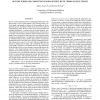16 search results - page 3 / 4 » Sharing Random Bits with No Process Coordination |
BMCBI
2004
13 years 7 months ago
2004
Background: For the purposes of finding and aligning noncoding RNA gene- and cis-regulatory elements in multiple-genome datasets, it is useful to be able to derive multi-sequence ...
ICASSP
2008
IEEE
14 years 1 months ago
2008
IEEE
Secure wireless communications is a challenging problem due to the shared nature of the wireless medium. Most existing security protocols apply cryptographic techniques for bit sc...
TCOM
2010
13 years 5 months ago
2010
—Physical (PHY) layer cooperation in a wireless network allows neighboring nodes to share their communication resources in order to create a virtual antenna array by means of dis...
BMCBI
2005
13 years 7 months ago
2005
Background: Microarray-CGH experiments are used to detect and map chromosomal imbalances, by hybridizing targets of genomic DNA from a test and a reference sample to sequences imm...
ISTCS
1992
Springer
13 years 11 months ago
1992
Springer
Concurrent Time-stamp Systems (ctss) allow processes to temporally order concurrent events in an asynchronous shared memorysystem, a powerful tool for concurrency control, serving...

